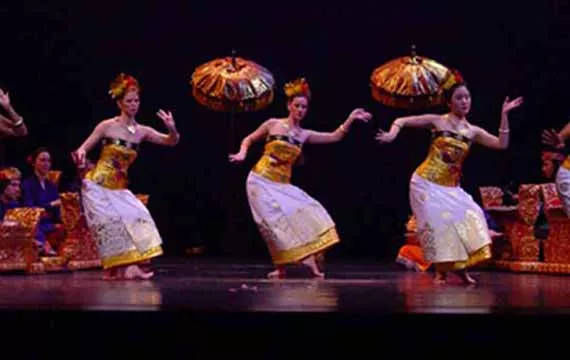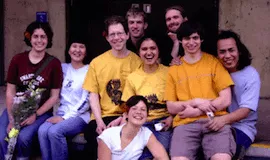About Gamelan Semara Santi

Gamelan Semara Santi
Founded in 1997, Gamelan Semara Santi is the Philadelphia area's only Gamelan (Indonesian percussion orchestra) devoted entirely to performance of traditional compositions from Bali, Indonesia. We perform twice a year on the campus of Swarthmore College in Swarthmore, Pennsylvania. All of our performances include both music and dance, as is typical in Bali. Some of our noteworthy activities include:
- We performed with the Philadelphia Orchestra at the Kimmel Center in Philadelphia and at Carnegie Hall in New York in October of 2003.
- We were profiled as part of the Creative Campus series produced by WHYY in Philadelphia. Our segment begins at about 09:35.
- We performed at the Philadelphia Shakespeare Theater in the spring of 2010.
- We performed at West Chester University College of Visual and Performing Arts in the spring of 2009.
- We performed at the First Annual Festival of World Music at the Painted Bride in Philadelphia in March of 2002.
- We were featured at the fall 2004 Chrysanthemum Festival at Longwood Gardens,Kennett Square, PA.
- We have also performed at Cabrini College and at the Sedgwick Cultural Center in the Mt. Airy section of Philadelphia.
- During the spring of 2000 we reconstructed a magnificent instrumental composition, Curik Ngaras, which was recorded in 1928 in Bali but subsequently fell out of the repertoire. Our concert marked the first time it was ever played outside of Bali.
- In the spring of 2001 we performed a complete Balinese Shadow Play (Wayang Kulit) in collaboration with Bali and Beyond of Los Angeles. For our performance, we modified the traditional music to enable our full gamelan, with about 25 musicians, to join in. It was probably the first performance of its kind anywhere in the world.
The musicians and dancers of Gamelan Semara Santi are students, faculty, staff, and friends from the extended community of Swarthmore College. Information about joining the ensemble is available. We rehearse as musicians in Indonesia do: we listen to one another and play by ear and by touch, without music notation. All of the notes and rhythms are precomposed and have been memorized. There is little room for improvisation in Balinese music.
The instruments of Gamelan Semara Santi were built in 1997 by I Wayan Beratha, a leading instrument maker, composer, performer, and teacher in Bali, Indonesia. View pictures of the instruments being maintained and tuned in 2007. Gamelan Semara Santi takes its name from Semar, the god of love, and Santi, the Sanskrit word for peace, to honor the peace-loving Quaker traditions of Swarthmore College.
About Balinese Gamelan
The word Gamelan, derived from a Javanese term for striking a percussion instrument, refers collectively to a set of musical instruments and, by extension, to the people who play them. Balinese Gamelan is perhaps best understood as a community undertaking. There are no soloists; each member of the ensemble contributes a small, yet necessary, component of the whole. The texture is organized according to the size of each instrument: the smaller an instrument is, the more frequently it plays. Thus, the high pitched, fast-moving ornamental layer is played by the reyong (small knob-gongs mounted horizontally) and gangsas (small bronze-keyed xylophones); the primary melody is both slower and lower- pitched, played by the ugal or gendér (medium xylophones); every second, fourth, or eighth tone of the primary melody is played in a lower octave by the ugal and jegogan (large xylophones); and the texture is punctuated by the suspended gongs, the largest of which plays only once per cycle. The largest gong is considered the spiritual center of the gamelan. Drummers direct the ensemble.
For more information about Gamelan:
If you would like more information about Balinese Gamelan, an excellent resource is Michael Tenzer's book, Balinese Music (1991: Periplus Editions)
A useful directory of Gamelan groups outside Indonesia.
For more information about the Music Department at Swarthmore College.
More information about Asian Studies at Swarthmore College.




